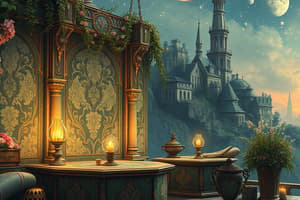Podcast
Questions and Answers
LINE – is a basic element of art referring to a continuous mark made on a surface by a moving point. A ______ is long relative to its width. It can define a space, create an out______ or pattern, imply movement or texture, and allude to mass or volume. Lines also are the path of a moving point. They define the edges of shapes and forms. Artist: Arturo Luz
LINE – is a basic element of art referring to a continuous mark made on a surface by a moving point. A ______ is long relative to its width. It can define a space, create an out______ or pattern, imply movement or texture, and allude to mass or volume. Lines also are the path of a moving point. They define the edges of shapes and forms. Artist: Arturo Luz
line
SHAPES - are limited to 2-D, flat and it is a line that connects to itself. Specifically, it is an enclosed space and the boundaries of which are defined by other elements of art. Artist: Pablo Picasso
SHAPES - are limited to 2-D, flat and it is a line that connects to itself. Specifically, it is an enclosed space and the boundaries of which are defined by other elements of art. Artist: Pablo Picasso
shapes
Artist: Vicente Manansala FORM - is a three-dimensional geometrical figure (i.e.: sphere, cube, cylinder, cone, etc.), as opposed to a shape that is two-dimensional
Artist: Vicente Manansala FORM - is a three-dimensional geometrical figure (i.e.: sphere, cube, cylinder, cone, etc.), as opposed to a shape that is two-dimensional
form
The ______ are the building blocks or foundations upon which a work of art is created. You will not use all of them all the time but you will use some of them most of the time.
The ______ are the building blocks or foundations upon which a work of art is created. You will not use all of them all the time but you will use some of them most of the time.
The elements and principles of art are the ______ or foundations upon which a work of art is created. You will not use all of them all the time but you will use some of them most of the time.
The elements and principles of art are the ______ or foundations upon which a work of art is created. You will not use all of them all the time but you will use some of them most of the time.
Flashcards are hidden until you start studying
Study Notes
Elements and Principles of Art
- The elements and principles of art serve as foundational components for creating artwork.
- Not all elements and principles are utilized in every artwork; however, a selection is typically applied.
Elements of Art
-
Line: A continuous mark made by a moving point, characterizing length relative to width.
- Defines spaces and edges of shapes.
- Creates outlines, patterns, and can imply movement or texture.
- Suggests mass or volume.
- Notable artist: Arturo Luz.
-
Shape: A two-dimensional, flat figure formed by a line that connects to itself.
- Represents an enclosed space defined by other art elements.
- Notable artists: Pablo Picasso, Vicente Manansala.
-
Form: A three-dimensional geometric figure such as a sphere, cube, cylinder, or cone, distinguishing it from two-dimensional shapes.
Studying That Suits You
Use AI to generate personalized quizzes and flashcards to suit your learning preferences.




